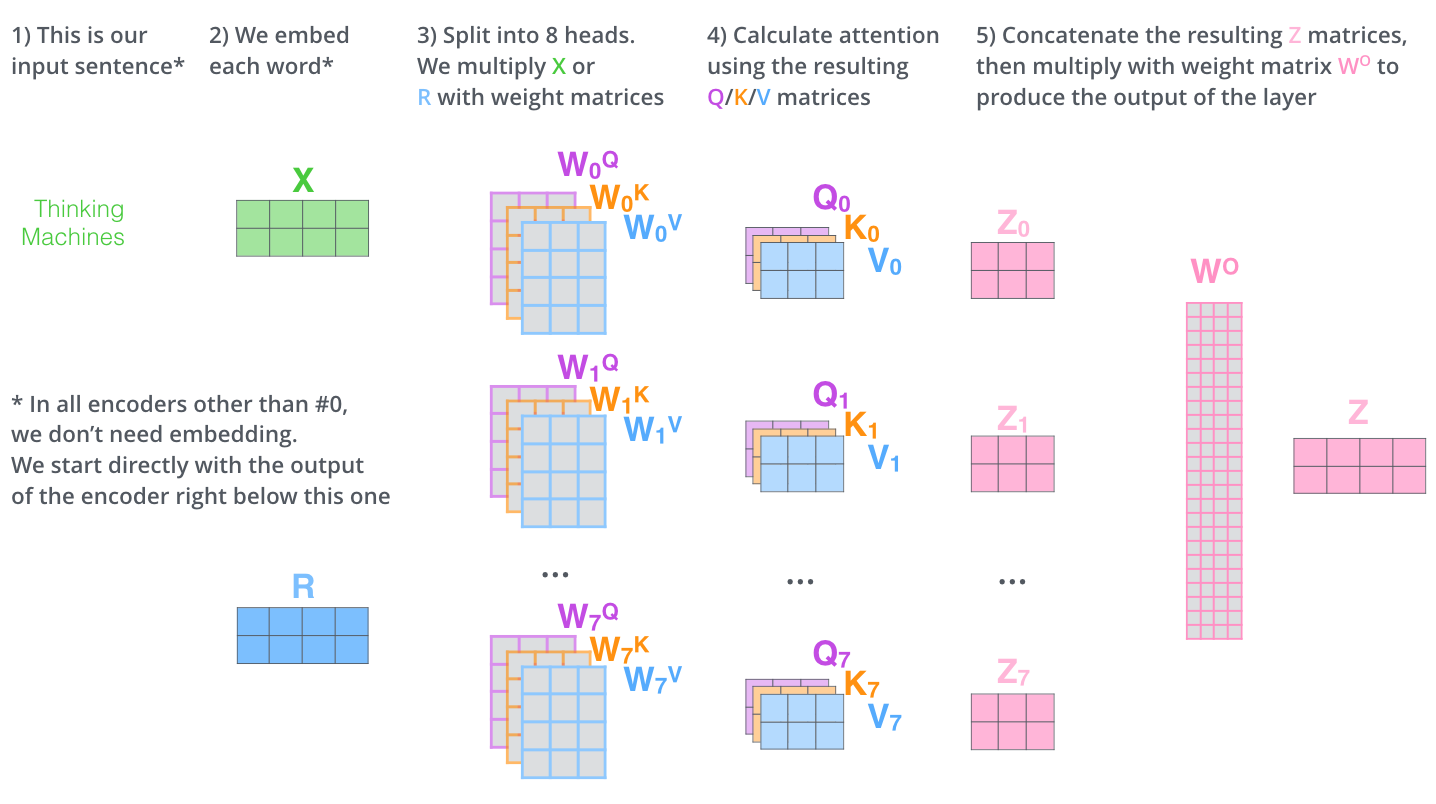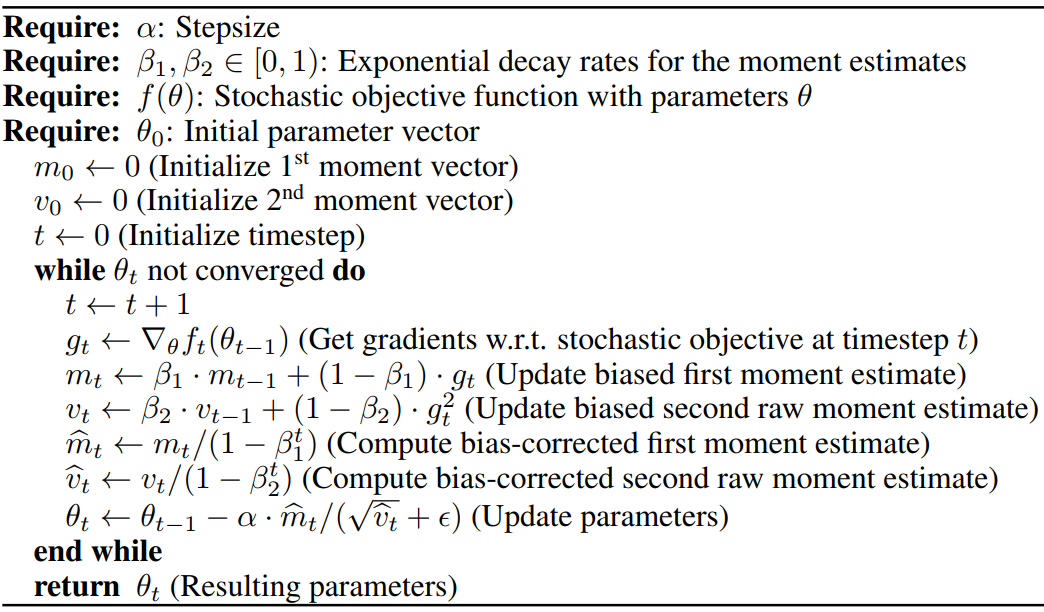谷歌在文章《Attention is all you need》中提出的transformer模型。如图主要架构:同样为encoder-decoder模式,左边部分是encoder,右边部分是decoder。
TensorFlow代码:https://www.github.com/kyubyong/transformer
用 sentencepiece 进行分词。
Encoder 输入
初始输入为待翻译语句的embedding矩阵,由于句子长度不一致,需要做统一长度处理,长度取maxlength1,不够长的句子padding 0值,句尾加上 </s> 。
d = 512, [batchsize,maxlen1,d]考虑到词语间的相对位置信息,还要加上语句的position
encoding,由函数形式直接求出。
PE(pos,2i) = sin(pos/10002i/d)
PE(pos,2i+1) = cos(pos/10002i/d)Padding的值不做position encoding。 [batchsize,maxlen1,d] ,最终:
encoder input = position encoding + input embedding。
encoder input : [batchsize,maxlen1,d]Encoder
Encoder 由N = 6个相同的layer连接组成。每个layer中有两个sublayer,分别是multihead
self-attention以及FFN。
Q = K = V = input
MultiHead(Q, K, V) = concat(head1, …, headh)Wo
headi = Attention(QWiQ,KWik,VWiV)
Attention(Q, K, V) = softmax(QKT/$$sqrt{d}$$) V


softmax前要做key_mask,把pad 0 的地方赋值为-inf,softmax后权重做query mask,赋值0。
h = 8
WiQ, Wik, WiV : [d, d/h]
Q : [maxlen_q, d]
K = V : [maxlen_k, d]
Maxlen_q = maxlen_k so: Q = K = V : [maxlen1, d]
QWkQ,KWik,VWiV : [maxlen1, d/h]
headi : [maxlen1, d/h] * [d/h, maxlen1] * [maxlen1, d/h] = [maxlen1, d/h]
Wo : [d, d]
MultiHead(Q,K,V): [maxlen, d]Softmax([maxlen_q, maxlen_k]) 在最后一个维度即 maxlen_k 上做 softmax。
position-wise是因为处理的attention输出是某一个位置i的attention输出。
FFN(x) = ReLU ( xW1 + b1 ) * W2 + b2
ReLU(x) = max( 0, x )
dff = 4 * d = 2048
W1 : [d, dff]
W2 : [dff, d]流程:
Input -> dropout ->
(
multihead self-attention -> dropout -> residual connection -> LN ->
FFN-> dropout -> residual connection -> LN ->
) * 6
-> memory [batchsize,maxlen,d]代码中在multihead attention中对score做dropout,FFN后没有dropout,但文章说每个sublayer的output都有一个dropout。
大专栏 Transformer详解:各个特征维度分析推导"#Decoder-输入" class="headerlink" title="Decoder 输入">Decoder 输入
训练
目标句子首尾分别加上 <s> , </s>。
Decoder input = Output embedding + position encoding
Decoder input : [batchsize,maxlen2,d]预测
初始向量为<s>对应embedding,之后将前一步的输出拼接到当前的所有预测构成当前的decoder输入。
Decoder
Decoder由N = 6 个相同的layer组成,每个layer中有三个sublayer,分别是multihead self-attention, mutihead attention以及FFN。
decoder input -> dropout ->
(
Masked multihead self-attention(dec, dec, dec) = dec-> dropout ->
multihead attention(dec, memory, memory) -> dropout -> residual connection
-> LN -> FFN -> dropout -> residual connection -> LN ->
) * 6
-> dec -> linear -> softmaxSelf-attention 的mask为一个和dec相同维度的上三角全为-inf的矩阵。
Linear( x ) = xW
Dec : [batchsize,maxlen2,d]
W : [d, vocabsize]W为词汇表embedding矩阵的转置, 输入输出的词汇表embedding矩阵为W。即三个参数共享。
Linear( x ) : [batchsize,maxlen2,vocabsize]Softmax函数:
损失函数
损失函数:cross entropy。用p代表predicted probability,用q代表groundtruth。即:
groundtruth为one-hot,即每个样本只有惟一的类别,$q(k)={{delta}_{k,y}}$,y是真实类别。
对目标句子onehot 做labelmsmooth用$tilde{q}(k|x)$代替$q(k|x)$。(为了正则化,防止过拟合)
可以理解为,对于$q(k)={{delta}_{k,y}}$函数分布的真实标签,将它变成以如下方式获得:首先从标注的真实标签的$delta$分布中取定,然后以一定的概率$varepsilon$,将其替换为在$u(k)$分布中的随机变量。$u(k)$为均匀分布,即$u(k)=1/K$
优化方法
Adam优化器:
学习率使用warm up learning rate:
learningrate = dmodel-0.5 * min ( step_num-0.5, step_num * warmup_steps-1.5 )
warmup_steps :4000